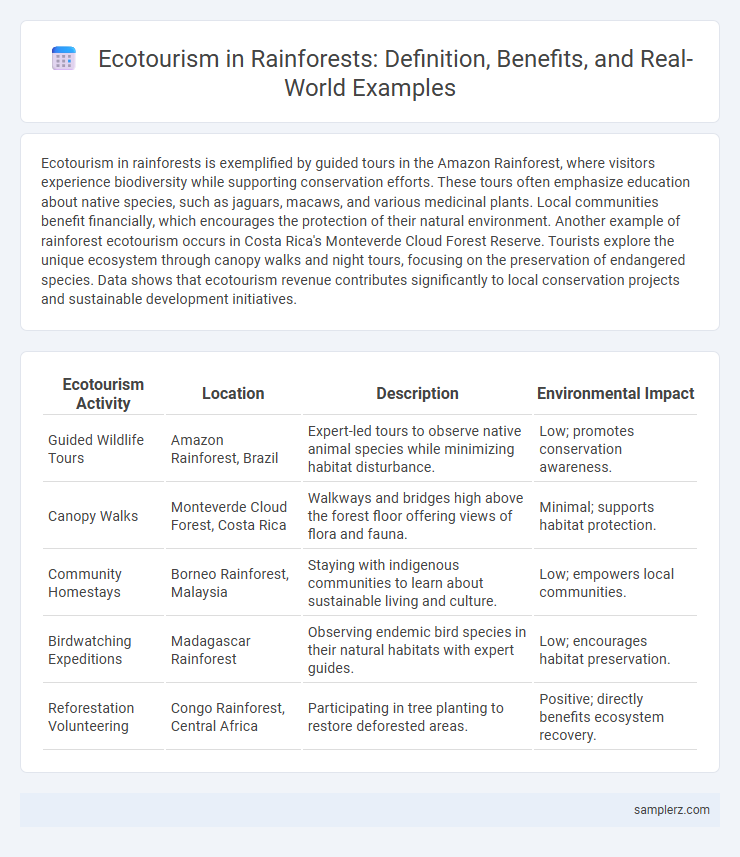Ecotourism in rainforests is exemplified by guided tours in the Amazon Rainforest, where visitors experience biodiversity while supporting conservation efforts. These tours often emphasize education about native species, such as jaguars, macaws, and various medicinal plants. Local communities benefit financially, which encourages the protection of their natural environment. Another example of rainforest ecotourism occurs in Costa Rica's Monteverde Cloud Forest Reserve. Tourists explore the unique ecosystem through canopy walks and night tours, focusing on the preservation of endangered species. Data shows that ecotourism revenue contributes significantly to local conservation projects and sustainable development initiatives.
Table of Comparison
| Ecotourism Activity | Location | Description | Environmental Impact |
|---|---|---|---|
| Guided Wildlife Tours | Amazon Rainforest, Brazil | Expert-led tours to observe native animal species while minimizing habitat disturbance. | Low; promotes conservation awareness. |
| Canopy Walks | Monteverde Cloud Forest, Costa Rica | Walkways and bridges high above the forest floor offering views of flora and fauna. | Minimal; supports habitat protection. |
| Community Homestays | Borneo Rainforest, Malaysia | Staying with indigenous communities to learn about sustainable living and culture. | Low; empowers local communities. |
| Birdwatching Expeditions | Madagascar Rainforest | Observing endemic bird species in their natural habitats with expert guides. | Low; encourages habitat preservation. |
| Reforestation Volunteering | Congo Rainforest, Central Africa | Participating in tree planting to restore deforested areas. | Positive; directly benefits ecosystem recovery. |
Top Ecotourism Destinations in Rainforests
The Amazon Rainforest in Brazil offers top ecotourism experiences with guided canopy tours and wildlife spotting of jaguars, macaws, and sloths in their natural habitats. Costa Rica's Osa Peninsula features sustainable lodges and conservation projects allowing visitors to explore untouched rainforests while supporting biodiversity preservation. In Malaysia, the Danum Valley Conservation Area provides immersive rainforest treks and river safaris emphasizing environmental education and protection of rare species like orangutans and hornbills.
Sustainable Lodges Deep in the Jungle
Sustainable lodges deep in the jungle offer an exemplary model of ecotourism by minimizing environmental impact through the use of renewable energy, waste reduction practices, and sourcing local materials. These lodges provide immersive experiences that promote conservation awareness while supporting indigenous communities economically. Visitors engage in guided tours that highlight biodiversity and encourage preservation of the rainforest ecosystem.
Community-Based Ecotourism Projects
Community-based ecotourism projects in rainforests empower local Indigenous communities by preserving biodiversity and promoting sustainable livelihoods. For example, the Osa Conservation in Costa Rica partners with local residents in the Osa Peninsula to protect endangered species while offering guided eco-tours that support community development. These projects emphasize cultural exchange, environmental education, and equitable revenue sharing to maintain rainforest ecosystems and improve the quality of life for indigenous populations.
Wildlife Conservation Tours in Rainforests
Wildlife Conservation Tours in rainforests offer travelers immersive experiences focused on protecting endangered species and preserving natural habitats. Participants engage in guided treks led by experts who monitor biodiversity, collect ecological data, and raise awareness about conservation challenges facing iconic animals such as jaguars, toucans, and poison dart frogs. These tours promote sustainable tourism practices that support local communities while contributing to vital rainforest preservation efforts.
Ethical Rainforest Trekking Experiences
Ethical rainforest trekking experiences emphasize sustainable practices that protect biodiversity and support local communities. Guided tours often follow established trails to minimize environmental impact while educating travelers about the ecosystem's delicate balance. Partnerships with indigenous groups ensure cultural respect and provide authentic insights into rainforest conservation efforts.
Indigenous-Guided Ecotourism Adventures
Indigenous-guided ecotourism adventures in rainforests offer travelers authentic cultural experiences while promoting environmental conservation and supporting local communities. These tours often include wildlife observation, traditional knowledge sharing, and sustainable practices that minimize ecological impact. Destinations like the Amazon Basin and Borneo exemplify how Indigenous stewardship enhances biodiversity protection and fosters meaningful connections between visitors and nature.
Unique Canopy Walks for Responsible Travelers
Unique canopy walks in rainforests provide responsible travelers with immersive eco-friendly experiences, allowing close observation of biodiversity while minimizing environmental impact. These elevated trails, such as the Kakum National Park Canopy Walkway in Ghana or the Monteverde Cloud Forest in Costa Rica, support conservation efforts and local communities by promoting sustainable tourism. Engaging with these treetop paths fosters environmental awareness and offers unparalleled views of rare flora and fauna in their natural habitat.
River Safaris Supporting Rainforest Protection
River safaris offer an immersive ecotourism experience that supports rainforest conservation by providing sustainable income to local communities. These guided boat tours highlight the diverse wildlife and unique ecosystems of the rainforest while promoting environmental awareness. By limiting environmental impact and funding protection efforts, river safaris contribute to preserving critical habitats and endangered species.
Volunteer Eco-Programs in Rainforest Regions
Volunteer eco-programs in rainforest regions offer immersive experiences that support conservation efforts and community development. Participants engage in activities such as reforestation, wildlife monitoring, and environmental education, helping to preserve biodiversity in places like the Amazon, Costa Rica, and Borneo. These programs foster sustainable tourism by promoting environmental stewardship and providing vital resources for local ecosystems and indigenous communities.
Best Practices for Low-Impact Rainforest Tourism
Low-impact rainforest tourism emphasizes sustainable practices such as guided tours on designated trails to protect biodiversity and minimize soil erosion. Eco-lodges powered by renewable energy sources and using biodegradable materials reduce environmental footprints while supporting local communities. Visitors are encouraged to engage in wildlife observation without disturbance and participate in conservation efforts, fostering a balance between tourism and rainforest preservation.

example of ecotourism in rainforest Infographic
 samplerz.com
samplerz.com